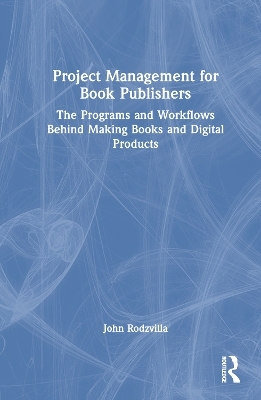
Project Management for Book Publishers
Routledge (Verlag)
978-1-032-51673-8 (ISBN)
Digital has brought more data, more training, and more accountability to the publishing process. But it has also shone light on how systems designed initially around print-first publications are ill-equipped to support an industry of now would-be digital media companies. This book addresses some of the major challenges for publishing houses facing this reality, including how to create a digital-aware workflow, implementing quality assurance procedures, and using different management systems to develop an efficient workflow. Beginning by explaining project and product management practices used throughout technology and media companies, it then delves into when and how these principles can be applied to the publishing workflow. Topics covered include Waterfall and Agile Project Management, Scrum methodology, Kanban framework, ebook and audio formats, metadata, quality assurance, crowdfunding, in-app monetization, ONIX, and accessibility. Readers will consider not just how to contend with online platforms that allow authors to publish with the click of a button, and audiences accustomed to accessing content across multiple platforms and formats, but also challenges arising from factors such as the data-driven acquisitions model in libraries, the downward spiral of sales in college bookstores, the call for accessibility, and the need for fluid content systems that can work with different publishing databases and software.
Written for publishing professionals at all levels, this book will also help advanced students of Publishing and Book Studies navigate best practices for project management in the modern publishing landscape.
John Rodzvilla is Assistant Professor of Digital Publishing in the Department of Writing, Literature and Publishing at Emerson College, Boston. He was previously the Graduate Program Director for the Master of Arts Degree in Publishing and Writing and the Senior Electronic Publisher-in-Residence at Emerson College.
List of Illustrations
Introduction
Publishing Technologies: Desktop Publishing and Markup Languages
Outline of Part I: Workflow and Project Management Theory
Outline of Part 2: Project Management in the Three Areas of Publishing
Part I: Workflow and Project Management Theory
Chapter 1: Modern Publishing Operations
The Book Publishing Process: Creation, Production, Distribution
A Process-Oriented Framework
Chapter 2: Publishing Workflows
Business Process Management
Workflow Modeling
Framing the Process
Mission Statement, Strategic Plan, and Culture of the Publishing House
Scope Statement
Risk Assessment
Goals and Objectives
Mapping the Work
The Interview Process
Creating Process Maps
Mapping with Sticky Notes
Issues in Mapping a Workflow: Variations and Systems as Actors
Assessment and Redesign of Publishing Processes
Assessment
Redesign Process
Course of Action Statement
Identify the Means of Measurement
Explain the Consequence of Inaction
Develop and Share New Process Maps
Chapter 3: Project Management
Project Management And Book Publishers
Functional Manager Versus Project Managers
The Project
The Project Team and Project Life Cycle
Project Constraints
Project Initiation
Project Planning
Project Execution
Project Closing
Chapter 4: The Linear Project Life Cycle
The Book as Linear Project
Initiation of the Book Project
Business Case
Project Charter
List of Stakeholders
Planning the Book Project
Development of the Book Project
Quality Control of the Book Project
Release of the Book Project
Closing of the Book Project
Concerns
Chapter 5: The Iterative Project Life Cycle
The Agile Model
The Agile Project Life Cycle
The Requirements Phase
User Stories
The Planning Phase
Kanban Board
The Design Phase
The Development Phase
Scrum
Scrum Roles
Scrum Meetings
Scrum tracking
Release
Repeat
Iterative Publishing Projects
Concerns
Part II: Project Management in the Three Areas of Publishing
Chapter 6: Content Creation Project Management
The Editorial Workflow
Editorial Project Management
Initiation of the Project
Project Planning
Development of the Project
Quality Control, Release, and Closing
Version Control and Asset Management
Content Creation and the Agile Method
Project Definition
User Stories and the MVP
Analyze Cost Versus Benefit
Risk Assessment
Emerging Technologies: Community Publishing, Analytics, and AI
Chapter 7: Content Production Project Management
The Production Workflow
Production Project Management
Initiation of the project
Project Planning
Budget
Scheduling
Development of the Project
Quality Control
Printed Books
Digital Books
Release
Closing
Content Production and the Agile Method
The Project Manager
Accessibility
Chapter 8: Content Distribution Project Management
The Distribution Workflow
Distribution Project Management
Marketing
Initiation of the Project
Project Planning
Development of the Project and Quality Control
Release
Closing
Promotion
Initiation of the Project and Project Planning
Development of the Project and Quality Control
Release
Closing
Sales
Initiation of the project
Project Planning
Development of the Project and Quality Control
Release
Special Sales, Library Sales, and Subsidiary Rights
Distribution
Closing
Book Returns
Metadata
Content Distribution and the Agile Method
User Feedback
Emerging Technologies
Crowdfunding
Digital and Print Subscriptions
Conclusion: Final Note
Index
| Erscheinungsdatum | 10.07.2024 |
|---|---|
| Zusatzinfo | 4 Tables, black and white; 17 Halftones, black and white; 17 Illustrations, black and white |
| Verlagsort | London |
| Sprache | englisch |
| Maße | 156 x 234 mm |
| Gewicht | 453 g |
| Themenwelt | Sozialwissenschaften ► Kommunikation / Medien ► Buchhandel / Bibliothekswesen |
| Wirtschaft ► Betriebswirtschaft / Management ► Marketing / Vertrieb | |
| Wirtschaft ► Betriebswirtschaft / Management ► Planung / Organisation | |
| Wirtschaft ► Betriebswirtschaft / Management ► Projektmanagement | |
| Wirtschaft ► Volkswirtschaftslehre | |
| ISBN-10 | 1-032-51673-9 / 1032516739 |
| ISBN-13 | 978-1-032-51673-8 / 9781032516738 |
| Zustand | Neuware |
| Haben Sie eine Frage zum Produkt? |
aus dem Bereich


